Apart from other aspects of giving we mentioned in this report, donation instances are also looked at from the side of intended effects they have. Accordingly, donations are categorized as either donations with intended short-term effects or long-term effects. Long-term donations refer to support that is supposed to provide a large number of beneficiaries with strategic solutions to problems, such as donation of equipment, scholarships, services, and capital investments; on the other hand, short-term donations provide immediate short-term solutions to a burning issue or symptom of a problem and include humanitarian support, provision of supplies and consumables, individual housing, and medical treatments to individuals.
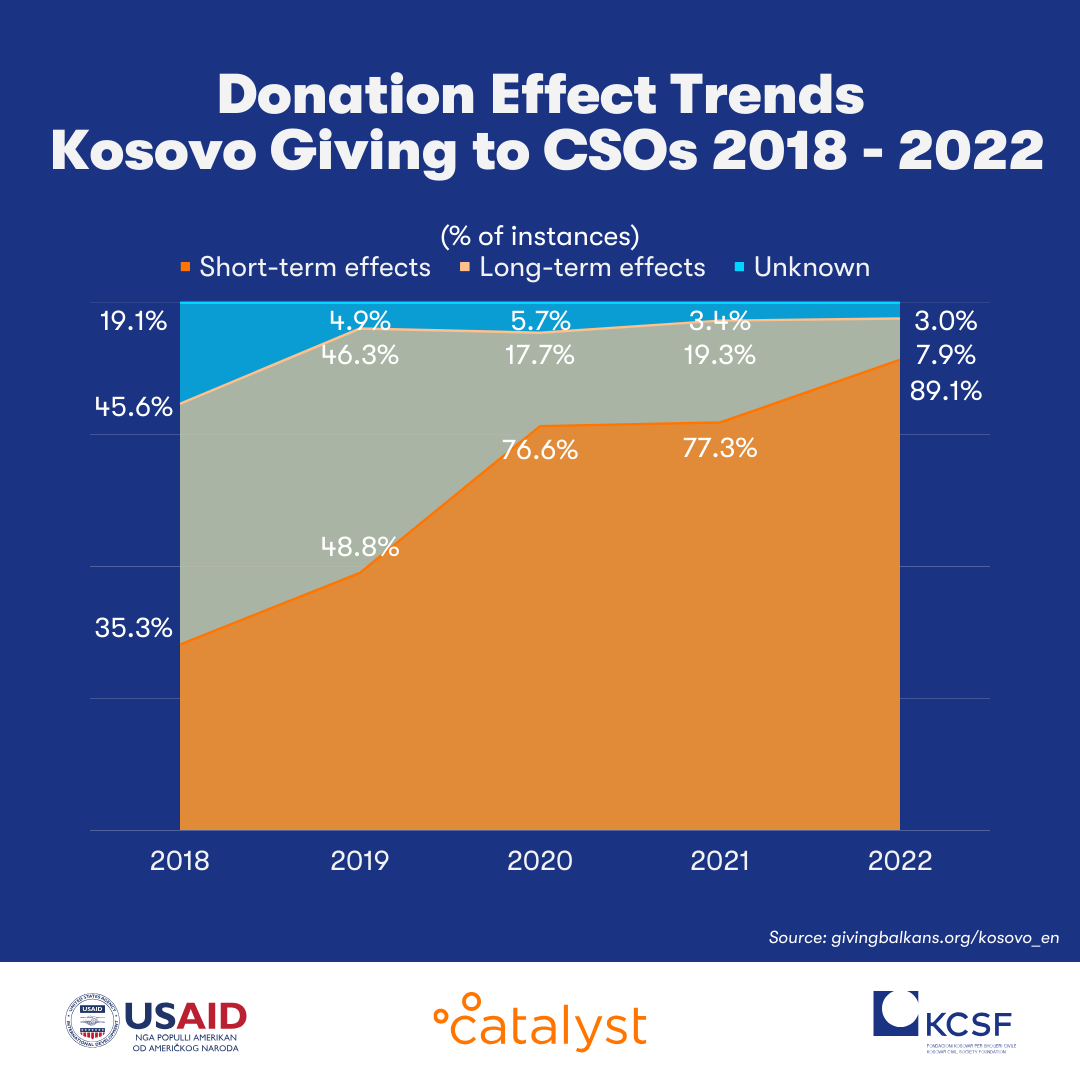
Giving to CSOs: Trends in intended Effects of Giving in Kosovo – 2018 – 2022 (% of instances)
Giving to CSOs: Intended Donation Effect Trend 2018 - 2022 - download the infographic in PDF
Throughout the last five years, a rising trend for giving with short-term effects was noted and reached its peak in 2022. This correlates with the rise in giving to socially disadvantaged people through CSOs, with the aim of providing necessary humanitarian support for immediate needs (food, clothes, cash donations, etc.). Consequently, the level of strategic giving in 2022 was at the lowest level since 2018, with only 8% of all donation instances directed to CSOs.
Breakdown of Short-Term Effect Giving in 2022

Graph: Giving to CSOs: Structure of Donations with Short-Term Effects
Giving to CSOs: Structure of Donations with Short-Term Effects (% of instances) – download the infographic in PDF
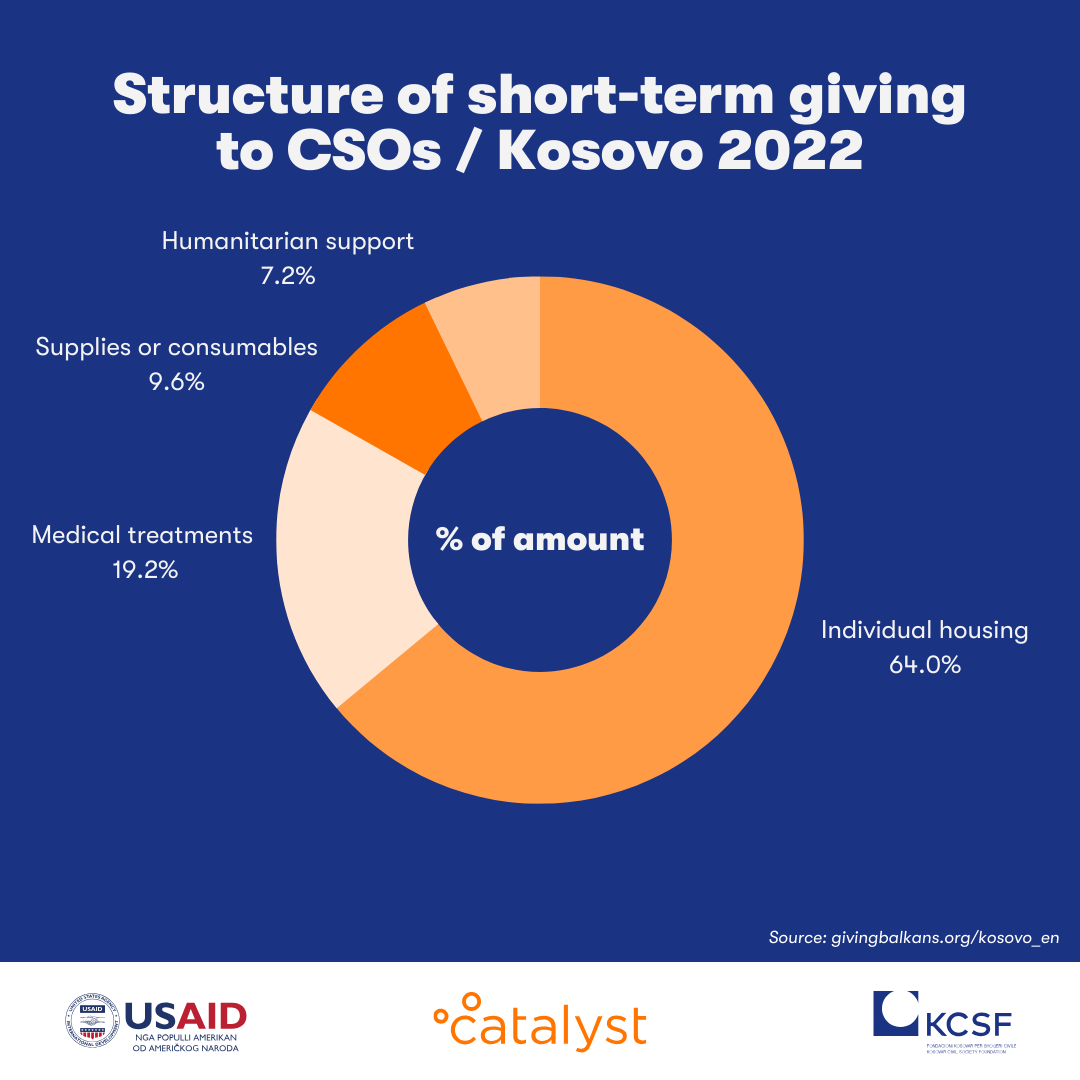
Giving to CSOs: Structure of Donations with Short-Term Effects (% of the amount) - download the infographic in PDF
Donations with short-term intended effects comprised almost 90% of both the number of instances and the total recorded amount for CSOs in 2022. In terms of frequency, out of all short-term giving, donations of supplies and consumables were the most frequent. Examples of such donations included the provision of food, clothes, hygienic packages, school materials, and other necessities. Regarding the value of donations, individual housing made up the largest percentage of the total amount.
Breakdown of Long-Term Effect Giving in 2022
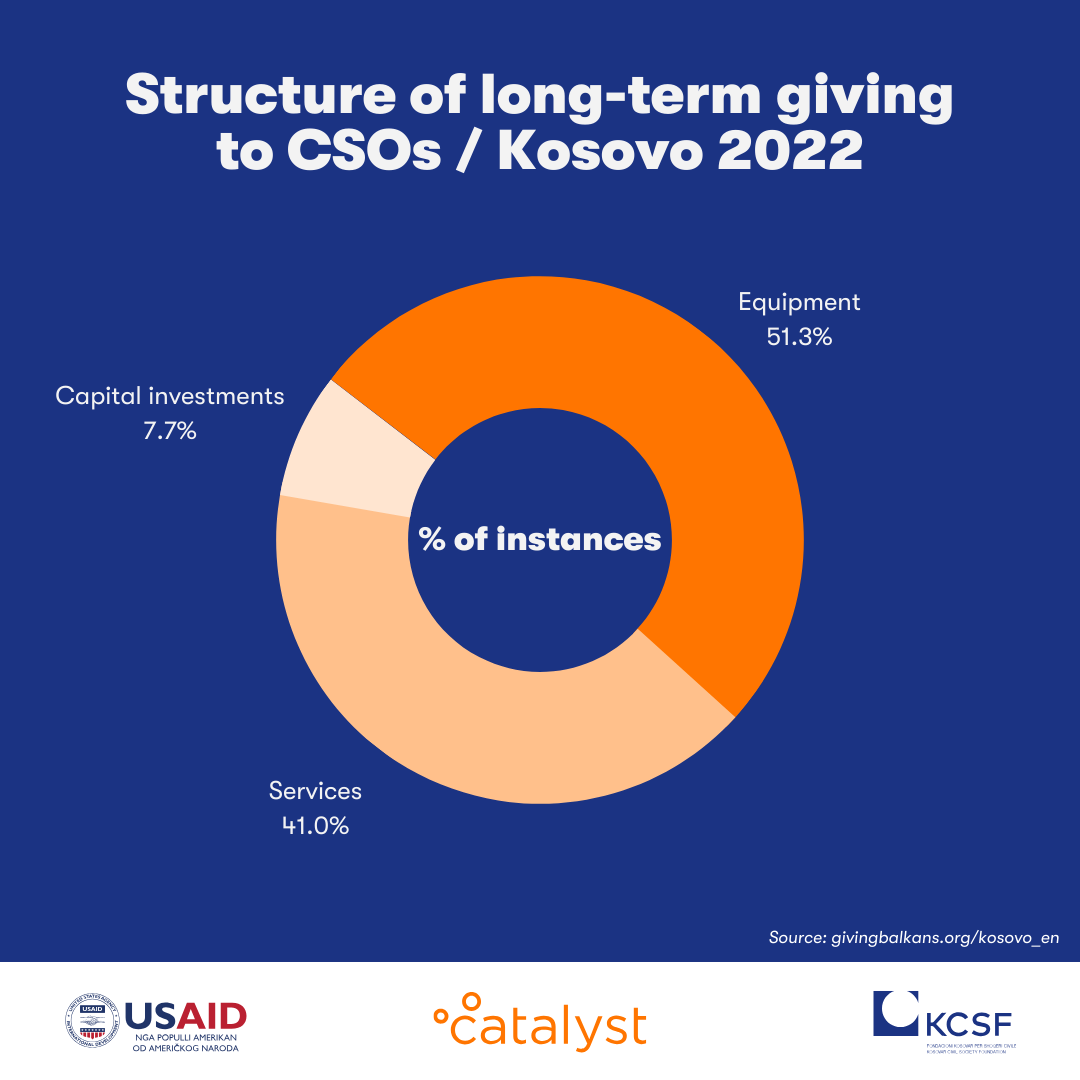
Graph: Structure of Long-Term Effect Giving in Kosovo in 2022
Giving to CSOs: Structure of Donations with Long-Term Effects (% of instances) - download the infographic in PDF
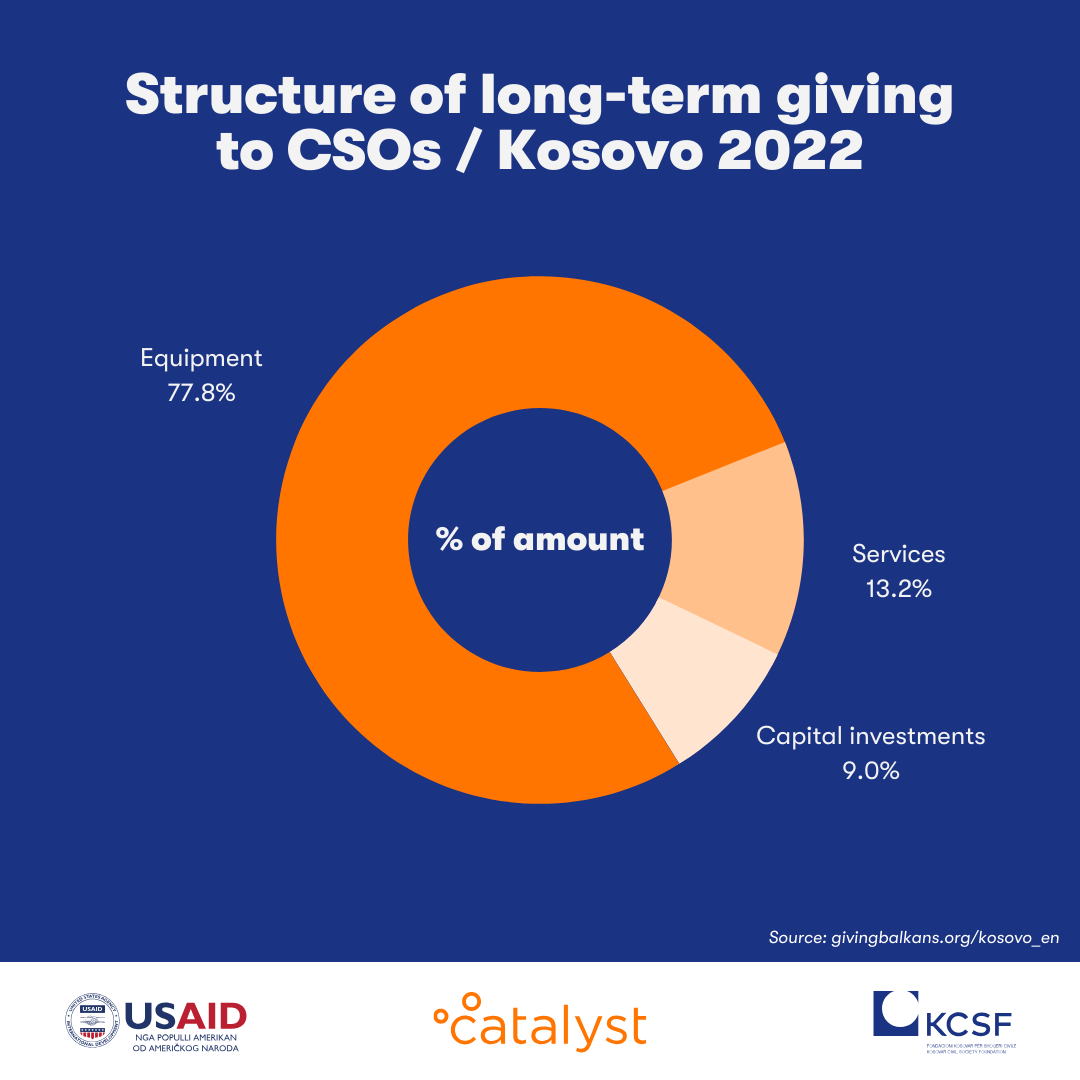
Giving to CSOs: Structure of Donations with Long-Term Effects (% of the amount) - download the infographic in PDF
Out of the total number of donation instances to CSOs in Kosovo in 2022, only a small portion were donations with long-term effects. More than half of strategic donations were donations in the form of equipment (assistive medical devices, medical equipment, vehicles, and others); services made up less than half of all strategic donations. Although the recorded share of long-term support for CSOs in 2022 is low compared to previous years, it is important to note that strategic giving is generally less frequent, both in Kosovo and other countries. In Kosovo, the most active CSOs are mainly focused on providing immediate help to people in need, and that is why one-off support is most common. We assume that a reason for that could be that short-term giving has generally lower monetary value and is “affordable” to people individually, and therefore it is more frequent. Additionally, we believe that the extent of strategic giving is not indicative of the quality of philanthropic giving but can be more a reflection of the current socio-economic conditions and the availability of resources accessible to donors to address both short-term and long-term issues at the same time.
Share of CSOs in Intended Effects 2022
Among all the recipients of support in Kosovo 2022, CSOs were the recipients that most frequently received donation instances with short-term intended effects. The above-mentioned basic needs’ support and individual housing for people in economic need were most commonly present. As for the strategic support, other recipients prevailed in the general philanthropic picture in 2022, and individual scholarships stood out.
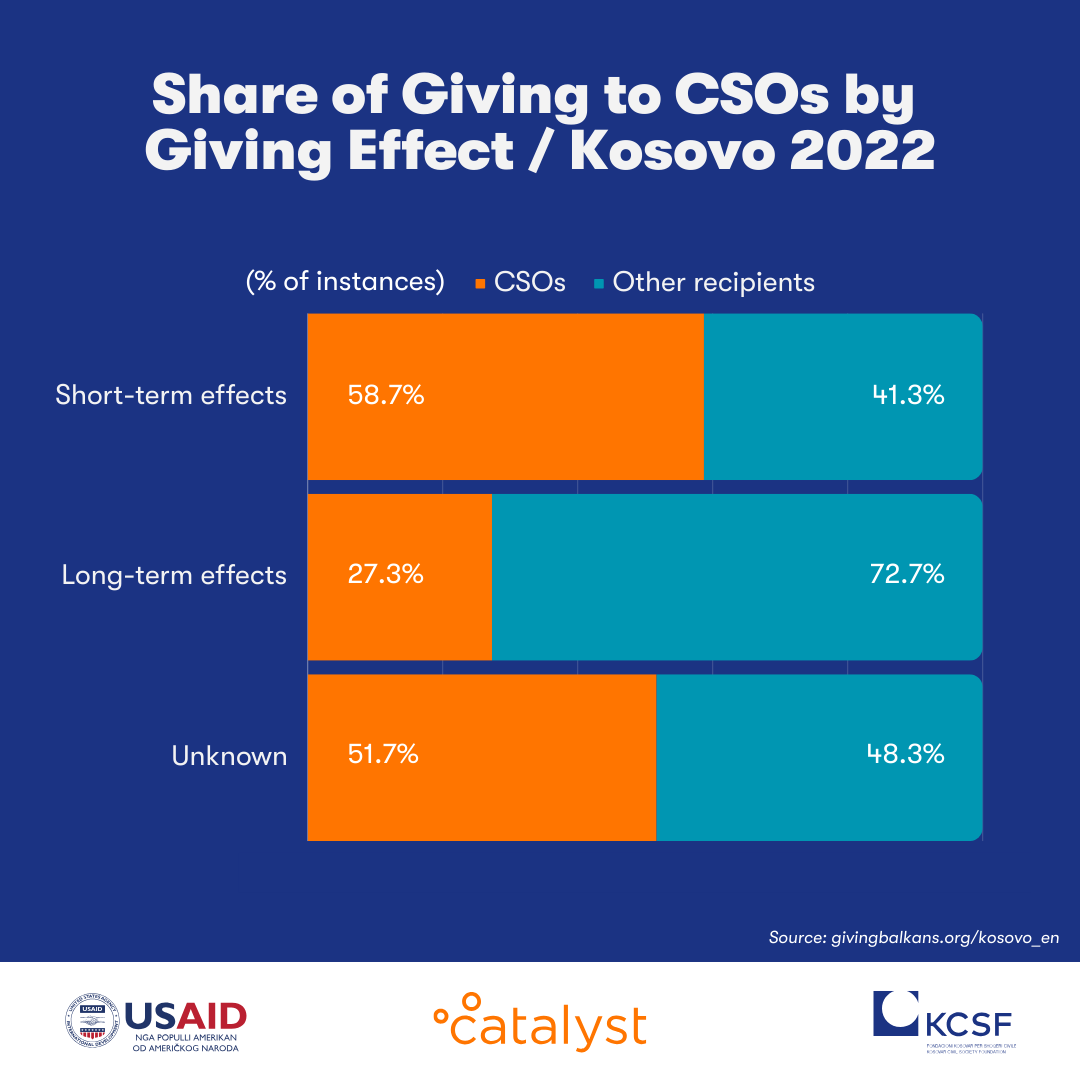
Intended Effects of Giving by Recipient type – 2022 (% of instances)
Giving to CSOs: Intended Effects of Giving by Recipient type – 2022 (% of instances) - download the infographic in PDF
Intended Effects of Giving: Examples of Giving
Support to marginalized groups through the work of CSOs
To mark the World Down Syndrome Day, the solidarity march under the motto “Ec Me Këpucët e Mia” (“Walk in My Shoes”) was held. The initiative was organized by the Down Syndrome Kosovo Association as part of the project “Një Kartolinë për Ty” (“A Postcard for You”). Citizens supported the campaign by direct donations and through symbolic purchases of postcards created by the members of the association. Stalls with postcards for sale were placed in cities throughout Kosovo. During the campaign, around EUR 38,600 was raised for activities of the organization in their work with people with disabilities.
Strategic giving through the work of CSOs
In 2022, Islamic Relief Kosovo distributed ten oxygen devices with a total value of EUR 8,000 to the municipality of Gjilan. Eight oxygen devices were intended for the needs of the Main Center for Family Healthcare (QKMF), while the rest were intended for other medical centers. The funds for the donated equipment were raised by citizens.
More on Kosovo’s support to nonprofits in 2022:
- Kosovo Gives to Civil Society Organizations 2022
- Donations to Civil Society Organizations in 2022: Focusing on Alleviating Poverty
- Giving to Civil Society Organizations in Kosovo 2022: Citizens’ support
- Civil Society Organizations in Kosovo: The neediest in focus
- Download the infographic: What were the intended effects of donations?
This report is made possible by the generous support of the American people through the United States Agency for International Development (USAID). The contents are the responsibility of Catalyst Balkans and do not necessarily reflect the views of USAID or the United States Government.
The Citizen Engagement Activity in Kosovo is a five-year initiative implemented by Kosovar Civil Society Foundation (KCSF) in partnership with the United States Agency for International Development (USAID).


Leave a comment